
|
xTuple ERP Reference Guide |
Work Orders define requirements for the production of manufactured Items. You may also create Work Orders for purchased items that you normally purchase, but you occasionally manufacture. These Items may have a Bill of Materials (BOM)—or not. The system supports both BOM-based and non-BOM-based Work Orders.
Material Requirements are drawn from the Bill of Materials when the Work Order is exploded, using the specified Revision. Users may add or subtract Material Requirements as needed.
Ideal for labor-only Work Orders having a Bill of Operations (BOO) but no BOM—for example, service Work Orders which require labor Operations only. Also good for Items or Jobs where the Material Requirements are not-known—but must be added on an ad-hoc basis.
To create a new Work Order, select the "Create New Work Order" option. The following screen will appear:
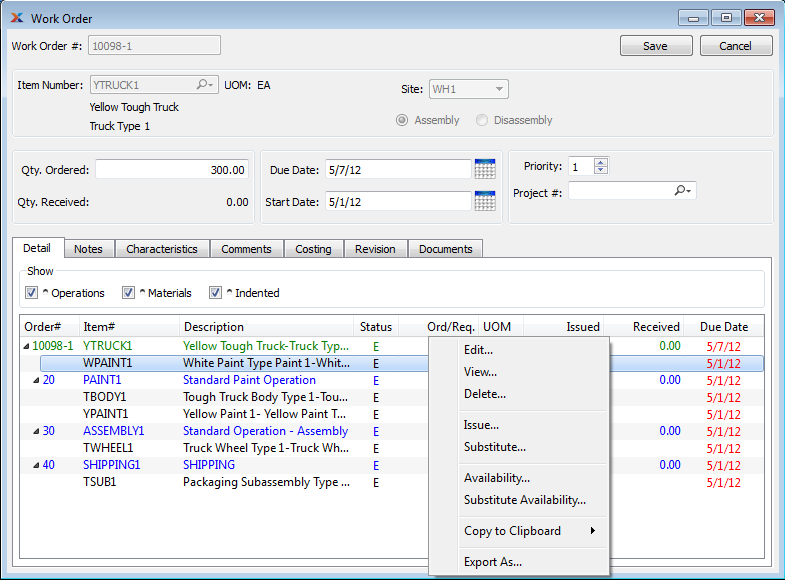
To edit a Work Order after it has been created, use the right-click menu in any of the "Work Order Schedule by..." displays. There you will find an "Edit W/O" option.
When creating a new Work Order, you are presented with the following options:
Next available Work Order Number will automatically display, unless your system requires you to enter Work Order Numbers manually. Default values and input parameters for Work Order Numbers are configurable at the system level.
Enter the Item Number of the Item you want to create a Work Order for. You may also enter purchased Items that you normally buy, but you occasionally make. The lookup feature located to the right of the field leads to a searchable list of make and buy items.
Work Orders for Job Items are created exclusively by Sales Order demand. It is not possible to create a Job Item Work Order using the Work Order screen. Similarly, production posting for Job Items occurs in a unique way. Production for Job Item Work Orders is posted when the Sales Order which demanded the Job Item is issued to Shipping. This is the only way to post production for Job Item Work Orders.
Inventory Unit of Measure.
Specify supplying Site for selected Item. Only Sites that contain supplying Item Sites for the selected Item may be chosen.
Order Parameters may have an impact on Work Order quantity if the "on Manual Orders" option is selected in the Item Site master for a manufactured Item. If Order Parameters are in effect, the Work Order must conform to those restrictions. Both Minimum Order size and Order Multiple may be governed by Order Parameter settings.
Select to identify the Work Order as an assembly order.
Select to identify the Work Order as a disassembly order. When disassembling Items, the system will not enforce order parameters defined at the Item Site level.
If there are Average Cost Items on a disassembly order, those components will be returned to inventory using Standard Cost when they are backflushed.
Value entered specifies the number of Item units to be processed by the Work Order.
Displays the quantity of finished product posted as received into Inventory to date, if any.
Select a number using the arrow buttons, or manually enter a value up to a maximum of 999. Value entered specifies the manufacturing Lead Time required between the date the Work Order starts and the date it is due. Lead Times for Items are specified in the Item Site master, but may be modified on this screen.
The Lead Time option is only available when creating a new Work Order. Once the Order is created, this option will not be visible.
Enter the date the Work Order must be completed by.
Enter the date the Work Order must be started by. By default, this date will be the due date less the Lead Time. The start date may be changed by altering the Lead Time field.
Select a number using the arrow buttons, or manually enter a value up to a maximum of 99. Value entered assigns a priority to the selected Work Order. By assigning a priority to a Work Order, you can indicate the relative importance of a Work Order in comparison to other Work Orders.
If your system is configured to use Projects, select a Project Number to associate with the Work Order. If the Work Order was created from Sales Order demand—and the parent Sales Order had a Project Number associated with it—then the Project Number from the parent Sales Order will automatically be entered here. In this way, Sales Orders and Work Orders may be linked to the same Project.
When you have the xTuple Project Accounting package installed—and you link a Project to the Work Order—transactions related to the Work Order will include the Project Number as the final segment of affected G/L Account Numbers. Account Numbers related to the following transactions will include the Project Number as the final segment: Issue Materials, Post Operations, Post Production, Return Material, Correct Post Operations, Correct Post Production, Scrap Material.
The "Detail" tab provides a kind of workbench for managing Materials, child Work Orders, and Operations associated with a Work Order. Use the context-sensitive right-click menu to perform actions related to Work Order management. The display is a nested list, with a plus ("+") sign located to the far left of the display next to each row that may be expanded to lower levels. By clicking your mouse on a plus sign, you reveal lower levels of information related to the group. The following color-coding has been implemented to simplify navigation: green (Work Orders), blue (Operations), black (Materials).
Specify the type of Work Order information you would like to include in the display:
Select to include information about Work Order Operations in the display.
Select to include information about Material Requirements in the display. Materials may be issued to exploded Work Orders only if that option is enabled in the Work Order configuration. For more information, please see Allow Issue To Exploded Work Orders.
Select to include child Work Orders in the display. If selected, child Work Orders will be shown indented in the Materials and Operations list.
Select to print a Work Order Traveler at the point when the Work Order is initially created. This option will be hidden once the Work Order has been created.
To add Notes to a Work Order, select the "Notes" tab. The following screen will appear:
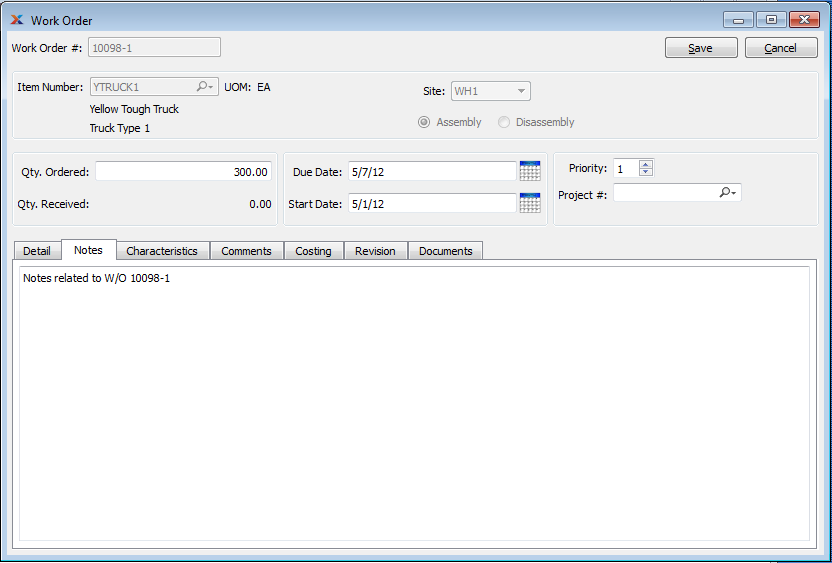
When adding Notes to a Work Order, you are presented with the following options:
This is a scrolling text field with word-wrapping for entering production Notes related to the Work Order. Production Notes are printed on Pick Lists and Packing Lists for reference by production personnel.
If a Work Order was created from a Sales Order, the Production Notes field will contain the Sales Order Number, the Customer Name, and any additional Sales Order Line Item Notes.
If an Item has Characteristics associated with it, you have the option of linking those Characteristics to a Work Order Item. And, in the case where a Work Order is generated from a linked Sales Order, the Work Order will inherit Characteristics defined at the Sales Order level.
You can link Characteristics and Values to an Item by using the Item master. Once entered, these Characteristics and Values will be available to users entering Sales Order Line Items.
To associate Characteristics with a Work Order Item, select the "Characteristics" tab at the bottom of the screen, as shown below:
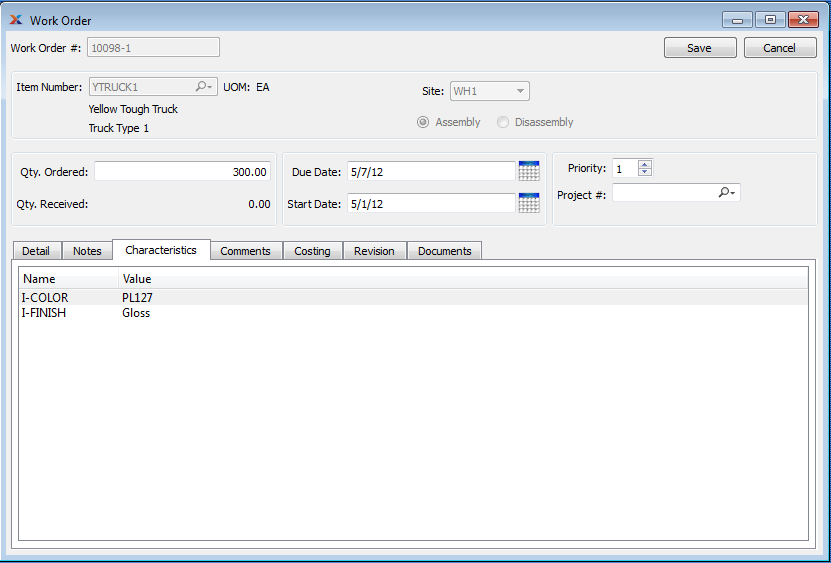
When specifying Characteristics for a Work Order Item, you are presented with the following options:
Displays the name of any Item Characteristics associated with the Item. Characteristics defined as Item Characteristics may be associated with Items on the Item master.
Displays the default Value associated with an Item Characteristic, but permits you to specify an alternate Value. When associating Characteristic Values with a Work Order Item, you have four options: 1) Select the default Value; 2) select an alternate pre-defined Value; 3) manually enter a new Value in place of the pre-defined Value; or 4) make no selection. Making no selection means the Characteristics will not be associated with the Work Order Item.
To create or view Comments related to a Work Order, select the "Comments" tab. The following screen will appear:
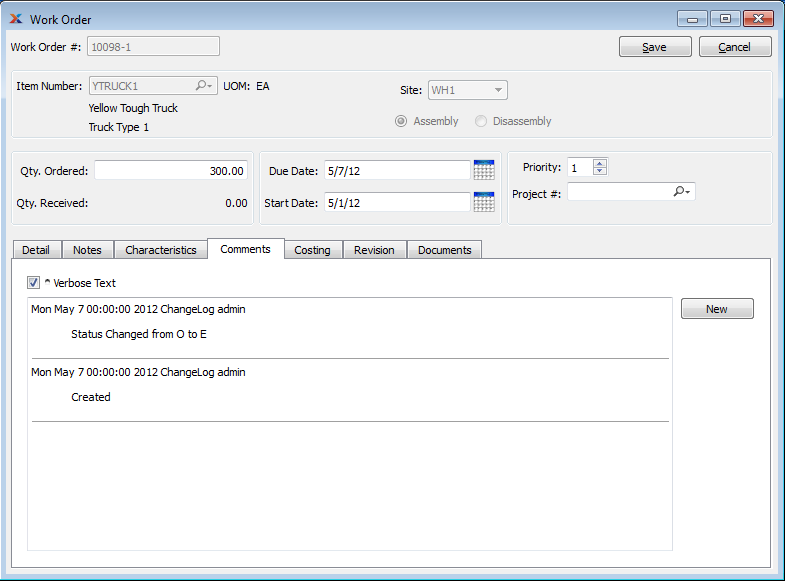
Work Order Comments may not be added at the time of Work Order creation. Instead, use the Production Notes tab for entering Notes related to a Work Order.
When adding or reviewing Comments, you are presented with the following options:
Select to display all Comments in the list in an expanded view which includes the entire text of each Comment. To edit a Comment, simply select the "Edit" link next to the Comment. That link will not be shown for Changelog Comments, which can't be edited. If the "Verbose Text" option is not selected, the Comment list will display only header level information for each Comment.
Display lists Comments related to the record.
The following buttons are available:
Opens screen for creating a new Comment.
Highlight a Comment and then select this button to reach a read-only view of the "Edit" screen.
Enables you to edit highlighted Comments—as long as the Comments are not "ChangeLog" Comments. ChangeLog Comments are system-generated and may not be edited. The edit screen is the same as that for creating a new Comment—except that when editing, the fields will contain Comment information. Double-clicking on a Comment will also bring you to the editing screen.
To enter a new Comment, select the NEW button. The following screen will appear:

Select a Comment Type from the drop-down list to classify the Comment. This is a required step. Comment Types may be system-defined (i.e., "ChangeLog" and "General") or user-defined, as described in Section 13.2.2, “Comment Types”. Once you have specified a Comment Type, begin typing your Comment in the main text area. The text area features word-wrapping and scroll-bar support for longer Comments.
The following buttons are unique to this screen:
Select to show the complete list (i.e., "thread") of Comments associated with the record. To hide the list, simply select the SHOW MORE button again. The Comment thread will show the most recent Comment first.
Once a Work Order is in process—that is, either Materials have been issued or Production or Operations have been posted—you can begin to view Costing information for the Work Order. To view Costing information for the Work Order, select the "Costing" tab. The following screen will appear:
The Costing tab will not be visible until after a Work Order has been created. You will not see Costing information when creating a Work Order.
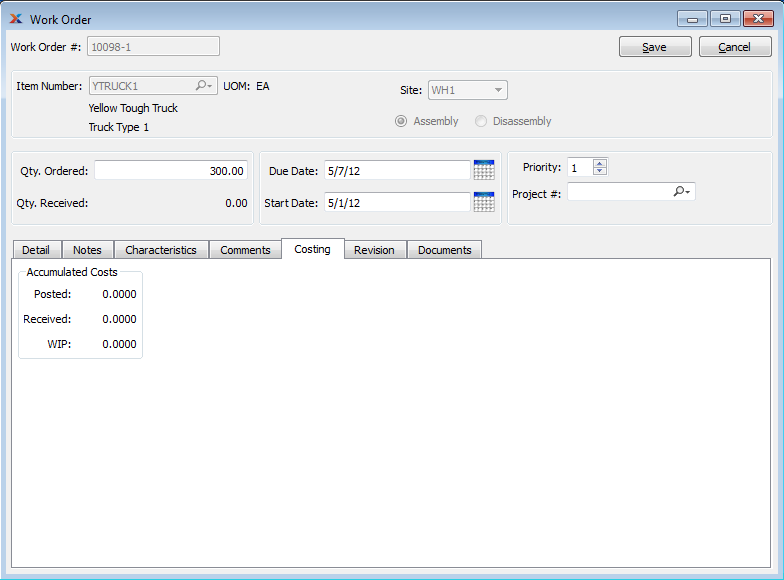
When viewing Work Order Costing information, you are presented with the following options:
Information about the following categories of currently accumulated Work Order Costs will be shown:
Displays the current posted value of the Work Order. The posted value is equal to the total cost accumulated on the Work Order, including both labor and Materials. The posted value will be the same as the WIP value until the point when finished goods are received. Ultimately, once Production (or Operations) posting is completed, the posted value will be equal to the received value. If these two values are different, then a variance will result.
Displays the current value of finished goods received into Inventory from the Work Order. The received value is equal to the posted value minus WIP.
Displays the current value of Work in Process (WIP) for the Work Order. The WIP value is equal to the posted value minus the received value.
Used by Work Orders for Job and Average Cost Items to determine how and when costs are recognized:
All of the costs accumulated against the Work Order will be debited to Inventory and credited to WIP.
Costs are recognized in proportion to the total costs posted and the total Items received to date.
The default Cost Recognition method is defined at the system level; however, you may change the setting manually at the Work Order level.
When creating a Work Order, you have the option to specify which Revision of the Work Order Item's Bill of Materials and Bill of Operations you want to use. By default, the active Revision will be used. Once the Work Order has been created, these options will become read-only. To specify Revision information for a Work Order Item, select the "Revision" tab. The following screen will appear:
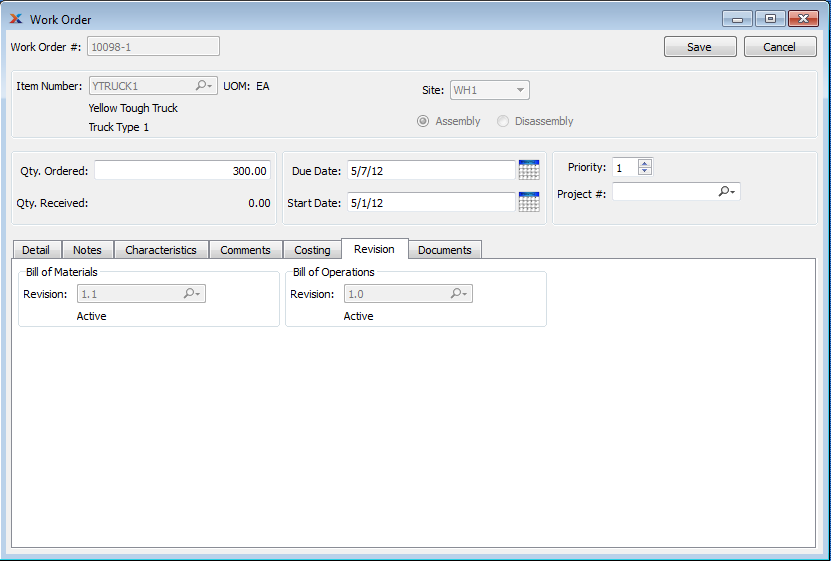
You may create Work Orders for pending Revisions. For Work Order purposes, a pending Revision is considered to be the same as an inactive Revision. The Revision status of a pending Revision will not be changed if a Work Order is created for it.
When specifying Revision information for a Work Order Item, you are presented with the following options:
Specify the BOM Revision you want to use for the Work Order. By default, the active Revision will be used.
Select from the list of existing available Revisions. The status of the Revision will also be displayed.
Specify the BOO Revision you want to use for the Work Order. You can select the current Active or any Substitute BOO. By default, the active Revision will be used.
Select from the list of existing available Revisions. The status of the Revision will also be displayed.
To view the documents associated with a Work Order, select the "Documents" tab. The following screen will appear:
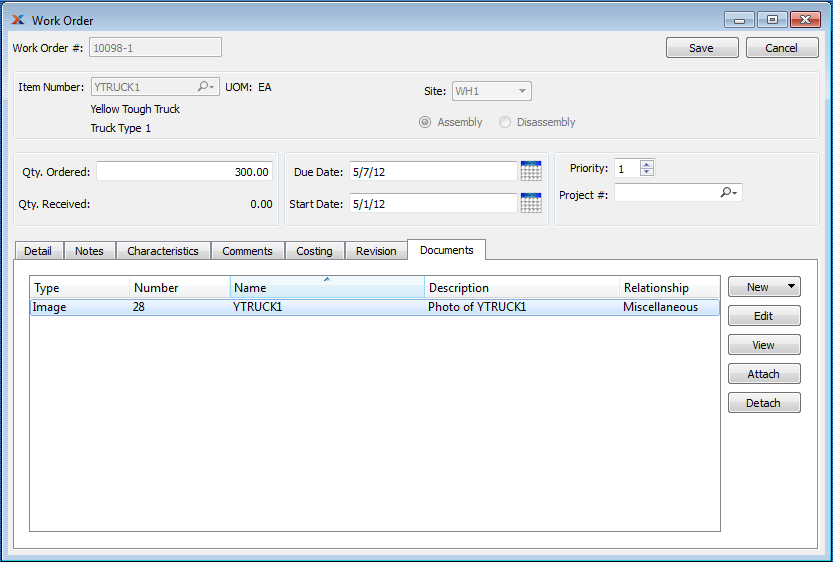
Work Order Documents
When associating documents, you are presented with the following options:
Select to create a new document and associate it with the current record. You may create the following document types:
Select to create a new Image association.
Select to create a new Incident and associate it.
Select to create a new To-Do and associate it.
Select to create a new Opportunity and associate it.
Select to create a new Project and associate it.
Enables you to edit associated documents. The edit screen is the same as that for creating a new document—except that when editing, the fields will contain document information. Double-clicking on a document will also bring you to the editing screen.
Highlight a document and then select this button to reach a read-only view of the "Edit" screen
Select to associate already-existing documents. The following document types may be attached: Contact, Account, Customer, Employee, File, Image, Incident, Item, Opportunity, Project, Purchase Order, Sales Order, Vendor, Web Site, Work Order.
Highlight a document and then select this button to remove the association.
To associate already-existing documents, select the ATTACH button. The following screen will appear:
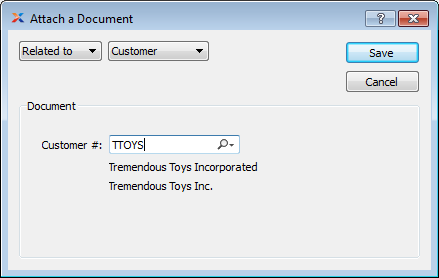
When associating already-existing documents, you are presented with the following options:
Indicate how the document is related to the current record. The following relationship options are available: Related to, Parent of, Child of, Duplicate of.
Specify the kind of document you want to associate. The following document types may be attached: Contact, Account, Customer, Employee, File, Image, Incident, Item, Opportunity, Project, Purchase Order, Sales Order, Vendor, Web Site, Work Order. When associating Files, you will also be given the option to save the File to the database.
There is no file size restriction when saving Files to the database. However, excessively large files could cause storage and performance issues.
Use the lookup field to identify the specific document you want to attach. The data entry options will vary depending on the document type you select.